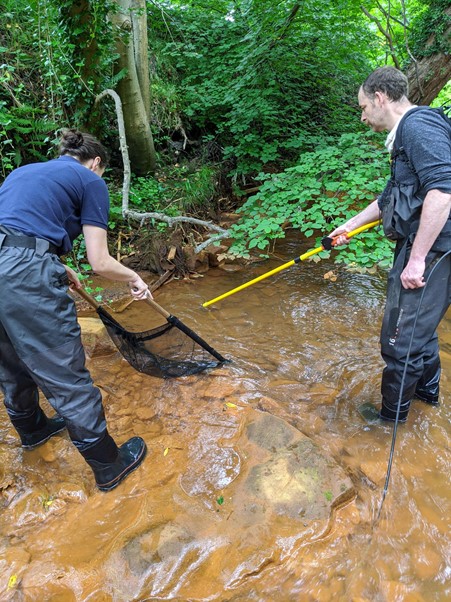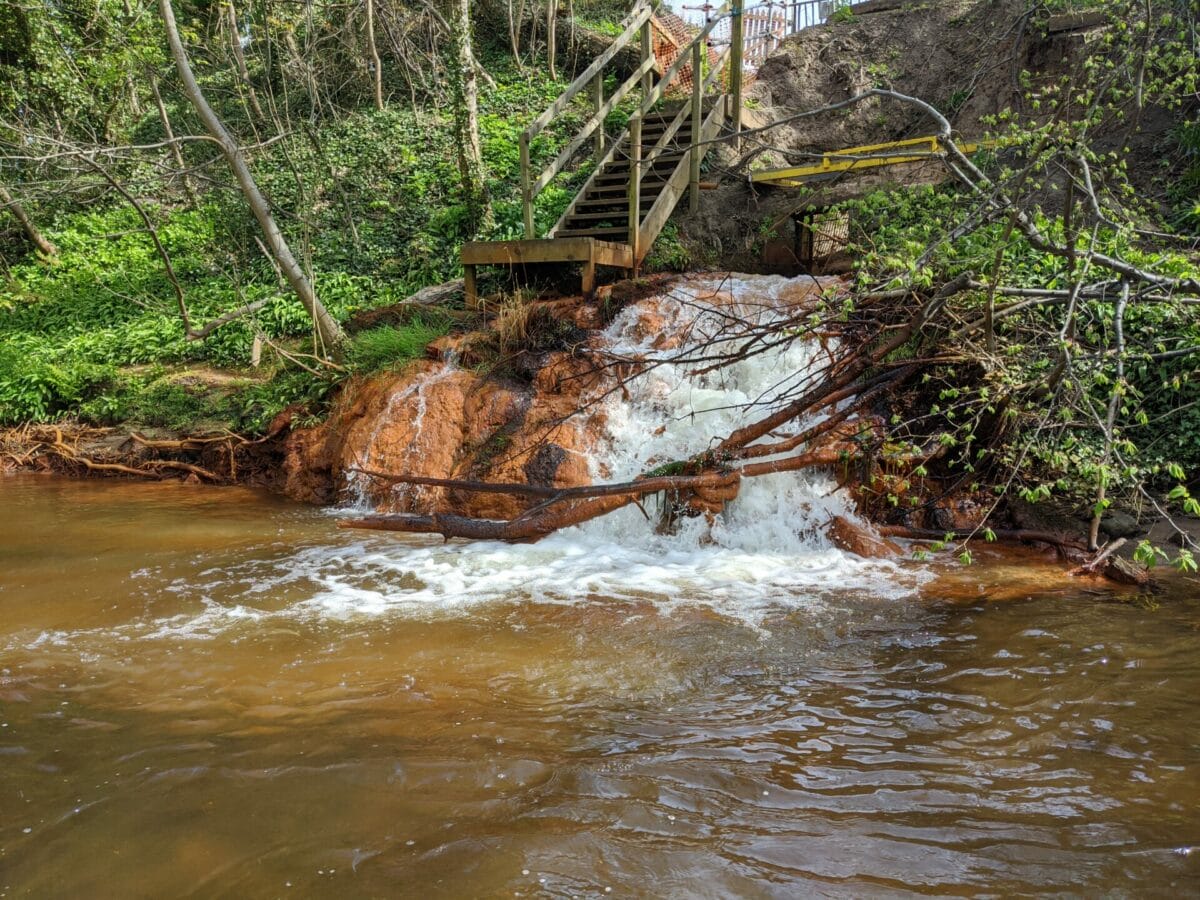More than 50 rivers and groundwaters have failed quality tests because they have been contaminated by toxic metals flowing from Scotland’s vast network of abandoned mines.
Coal and metal mining was a key part of Scotland’s industrial history for hundreds of years, but potentially toxic heavy metals are still being flushed out from forgotten tunnels, putting wildlife, crops and water ecology at risk.
Climate change is likely to worsen the issue, with heavier rainfall washing out even more metals from flooded mines, and less rainwater available to dilute mine water in drier summers.
Groundwaters – water found below the surface – of many of Scotland’s biggest towns and cities are contaminated with mining metals and, according to one study, mine pollution has killed off the salmon population in Midlothian’s South Esk river.
Opposition MSPs urged the Scottish Environment Protection Agency (Sepa) to set out its plans to make disused mines safe.
Sepa said it was committed to tackling the “complex challenge” of mine water pollution alongside the UK Government’s Coal Authority, which owns Scotland’s former coal mines and shares responsibility for their environmental impacts.
Thirteen mine water treatment schemes have been established by the Coal Authority so far, with another planned for Dalkeith in Midlothian. Sepa was seeking partners and funding to reduce metal mining’s “most severe impacts”.

Data Sepa shared with The Ferret shows that 33 groundwaters failed their most recent water quality tests due to historic coal mining, with two more affected by former metal mining.
They include Alloa, Ayr, Dalkeith, Dunfermline, East Kilbride, Falkirk, Glasgow, Kilmarnock, Kirkcaldy, Livingston, Motherwell, Paisley and Stirling.
Coal mine pollution caused 11 rivers to fail water quality standards, with a further five impacted by metal mining. Metal-polluted rivers include the Esk in the Lothians, the Nith in Dumfriesshire, and the Fillan in Stirlingshire, which flows near Crianlarich and Tyndrum.
Mining metals present in Scotland’s waterways include cadmium, iron, lead, manganese and zinc. Polluted groundwater can threaten drinking water supplies, according to England’s Environmental Agency.
Scottish rivers polluted by mine water
| Water body | Type | Affected by |
|---|---|---|
| Breich Water/Darmead Linn | River | Coal Mining |
| How Burn | River | Coal Mining |
| Boghead Burn/Bog Burn/Couston Water | River | Coal Mining |
| River South Esk (Gore Water to N Esk confluences) | River | Coal Mining |
| Keithing Burn (Craiganet Burn to Estuary) | River | Coal Mining |
| Lochfitty Burn | River | Coal Mining |
| Den Burn | River | Coal Mining |
| Lochty Burn | River | Coal Mining |
| Lyne Burn | River | Coal Mining |
| South Calder Water (u/s Auchter Water) | River | Coal Mining |
| Poniel Water | River | Coal Mining |
| R Fillan | River | Metal Mining |
| Glengonnar Water | River | Metal Mining |
| River Nith (Dumfries – Sanquhar) | River | Metal Mining |
| Crawick Water/Spango Water | River | Metal Mining |
| Wanlock Water | River | Metal Mining |
| Dalquharran Coalfield | Groundwater | Coal Mining |
| Airth | Groundwater | Coal Mining |
| Kinneil | Groundwater | Coal Mining |
| Stenhousemuir | Groundwater | Coal Mining |
| Douglas Coalfield South | Groundwater | Coal Mining |
| Linwood | Groundwater | Coal Mining |
| Falkirk | Groundwater | Coal Mining |
| Denny | Groundwater | Coal Mining |
| Sanquhar | Groundwater | Coal Mining |
| Culross | Groundwater | Coal Mining |
| Alloa | Groundwater | Coal Mining |
| Douglas Coalfield North | Groundwater | Coal Mining |
| Slamannan | Groundwater | Coal Mining |
| Paisley and Pollok | Groundwater | Coal Mining |
| Dalkeith | Groundwater | Coal Mining |
| Penicuik | Groundwater | Coal Mining |
| Stirling | Groundwater | Coal Mining |
| Forth | Groundwater | Coal Mining |
| Dalry | Groundwater | Coal Mining |
| East Kilbride | Groundwater | Coal Mining |
| Armadale | Groundwater | Coal Mining |
| Kirkintilloch | Groundwater | Coal Mining |
| Methil | Groundwater | Coal Mining |
| Gorebridge | Groundwater | Coal Mining |
| Dunfermline and Kirkcaldy | Groundwater | Coal Mining |
| Cumnock | Groundwater | Coal Mining |
| Kilmarnock | Groundwater | Coal Mining |
| Ayr | Groundwater | Coal Mining |
| Glasgow and Motherwell | Groundwater | Coal Mining |
| Livingston | Groundwater | Coal Mining |
| Balbeggie | Groundwater | Coal Mining |
| Grangemouth | Groundwater | Coal Mining |
| Whitburn | Groundwater | Coal Mining |
| Upper Nithsdale | Groundwater | Metal Mining |
| Leadhills | Groundwater | Metal Mining |
Mine water risk to wildlife and the environment
The Forth Rivers Trust warns that mine water pollution can have “a devastating impact on rivers, wildlife and communities”. As freshwater invertebrates are more sensitive to pollution, their disappearance can give an early indication of metal contamination.
But river insects are also a key food source for fish and birds, so their wellbeing can impact entire food chains.
A 2020 study by the trust found fish numbers in the River South Esk to be significantly higher upstream of a mine water pollution leak.
“The effects of this discharge are so great the last remnants of salmon in the South Esk have died off completely due to the toxic chemicals damaging spawning grounds and food sources,” Jonathan Louis, the trust’s co-director, told The Ferret.
Mining pollution from metals like lead and cadmium are invisible, but when iron reaches a river, it oxidises and settles on the waterbed, causing rivers to run orange. In the South Esk, Louis recalled a bevy of swans stained orange due to the concentration of iron in the water.
He added: “Mine water pollution is tricky to tackle but not impossible and more needs to be done to ensure rivers, wildlife and communities recover from past industrial practices.”
Land can also be contaminated with metals from mine water after flooding. At least 23m people worldwide live on floodplains contaminated by high concentrations of toxic metal mining waste, according to a study from the University of Exeter published in September.
We are in a biodiversity crisis and this type of toxic pollution has a huge impact on animal and plant health at the worst possible time.
Mercedes Villalba MSP, Scottish Labour
High concentration of metals in soils can be transferred to crops grown on contaminated land, or to animals grazing on it, particularly after flooding.
Longannet Mine in Fife – Scotand’s last coal mine to close – was shut in 2002 due to severe flooding. A farmer whose land lies above the abandoned mine claimed the mine has caused extensive flooding damage to his land. Other mines have been deemed to be unsafe.
Earlier this year, The Ferret found that disused opencast coal mines still make up several of Scotland’s largest derelict sites.
We also reported that in 2016, a sub-standard maintenance job from the Coal Authority led to South Lanarkshire’s Dippool Water – part of the Clyde river system – running red with ochre sediment from a nearby mine water treatment facility.
Data we obtained via freedom of information shows that at least 58 reports of alleged mine pollution from the public were logged by Sepa over five years since October 2018 – 53 of which took place between January 2021 and August this year.
Sepa stressed that it had not substantiated these reports, meaning that the issues may not have actually been caused by mines. Other reports may have been lost due to its 2020 criminal cyber-attack, Sepa added.

Sepa urged to set out mine water risks
Scottish Labour’s environment spokesperson, Mercedes Villalba MSP, said: “We are in a biodiversity crisis and this type of toxic pollution has a huge impact on animal and plant health at the worst possible time.
“Record rainfall as a result of the worsening climate crisis, like the kind we’ve seen in parts of Scotland in recent weeks, will only make these instances more prevalent.
“The Scottish Government must work proactively to make disused mines safe, not just the sites themselves, but in terms of the wider environmental impact.”
The Liberal Democrat’s Liam McArthur MSP acknowledged that tackling pollution caused by Scotland’s industrial past is “undoubtedly challenging”.
But he added: “The news that dozens of rivers and groundwaters have failed Sepa’s latest tests will undoubtedly cause some public concern so it would be helpful if the environmental regulator could make clear whether any of these sites pose a risk to people, pets and wildlife and what steps are being taken to reduce this pollution.”
Sepa said local NHS boards and environmental health departments advise the public whether contaminated waters pose a health risk. NHS Scotland had found that mine pollution in the South Esk, and the waters around Wanlockhead, Dumfriesshire, and Leadhills, South Lanarkshire, did not pose a significant risk to health, for example.

Paul Butler, Sepa’s mining sector lead, said: “Pollution as a result of discharges from former coal mine workings is a complex challenge, but one we are committed to addressing alongside the Coal Authority.
“Together we are undertaking comprehensive monitoring to understand the impact of mining on Scotland’s water environment, and prioritising interventions where they will have the greatest benefit.”
Sepa “will aim to address a major mine water discharge which impacts several kilometres of the River South Esk and River Esk,” added Butler.
The Coal Authority said it worked with Sepa “to understand and take practical action to support safer, cleaner and greener communities”.
“This can include building and operating mine water treatment schemes, which are prioritised in collaboration with Sepa, dependent on several factors including environmental impact,” said Andy Morritt, the authority’s head of environment strategy and sustainability.
“In 2022/23, our 13 existing mine water treatment schemes in Scotland treated 29bn litres of water, preventing 708 tonnes of iron solids from entering local watercourses. They protected and enhanced the natural environment providing biodiversity and social value.”
Mine pollution remediation projects are underway elsewhere in the UK. In 2021, Natural Resources Wales identified 129 disused sites polluting nearby rivers and burns. But ending pollution could cost the country as much as £282m.
Earlier this year, the UK Government set out aims to halve the length of English rivers polluted by harmful metals from abandoned mines by 2038.














